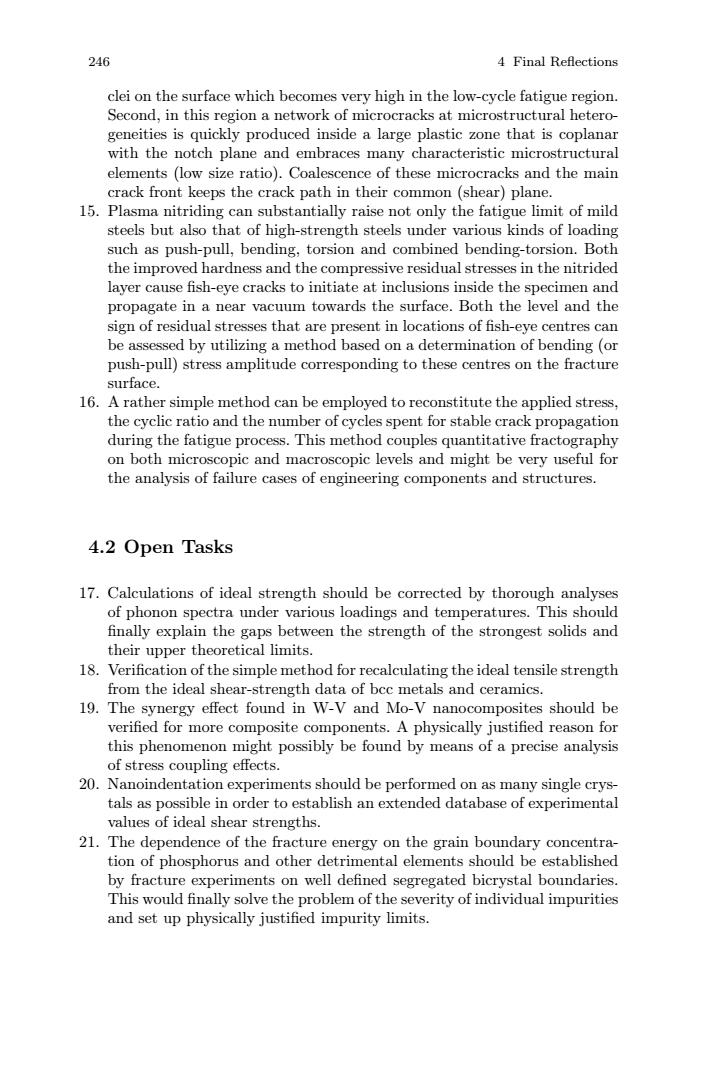正在加载图片...

246 4 Final Refections clei on the surface which becomes very high in the low-cycle fatigue region. Second,in this region a network of microcracks at microstructural hetero- geneities is quickly produced inside a large plastic zone that is coplanar with the notch plane and embraces many characteristic microstructural elements (low size ratio).Coalescence of these microcracks and the main crack front keeps the crack path in their common (shear)plane. 15.Plasma nitriding can substantially raise not only the fatigue limit of mild steels but also that of high-strength steels under various kinds of loading such as push-pull,bending,torsion and combined bending-torsion.Both the improved hardness and the compressive residual stresses in the nitrided layer cause fish-eye cracks to initiate at inclusions inside the specimen and propagate in a near vacuum towards the surface.Both the level and the sign of residual stresses that are present in locations of fish-eye centres can be assessed by utilizing a method based on a determination of bending (or push-pull)stress amplitude corresponding to these centres on the fracture surface. 16.A rather simple method can be employed to reconstitute the applied stress, the cyclic ratio and the number of cycles spent for stable crack propagation during the fatigue process.This method couples quantitative fractography on both microscopic and macroscopic levels and might be very useful for the analysis of failure cases of engineering components and structures. 4.2 Open Tasks 17.Calculations of ideal strength should be corrected by thorough analyses of phonon spectra under various loadings and temperatures.This should finally explain the gaps between the strength of the strongest solids and their upper theoretical limits. 18.Verification of the simple method for recalculating the ideal tensile strength from the ideal shear-strength data of bcc metals and ceramics. 19.The synergy effect found in W-V and Mo-V nanocomposites should be verified for more composite components.A physically justified reason for this phenomenon might possibly be found by means of a precise analysis of stress coupling effects. 20.Nanoindentation experiments should be performed on as many single crys- tals as possible in order to establish an extended database of experimental values of ideal shear strengths. 21.The dependence of the fracture energy on the grain boundary concentra- tion of phosphorus and other detrimental elements should be established by fracture experiments on well defined segregated bicrystal boundaries. This would finally solve the problem of the severity of individual impurities and set up physically justified impurity limits.246 4 Final Reflections clei on the surface which becomes very high in the low-cycle fatigue region. Second, in this region a network of microcracks at microstructural heterogeneities is quickly produced inside a large plastic zone that is coplanar with the notch plane and embraces many characteristic microstructural elements (low size ratio). Coalescence of these microcracks and the main crack front keeps the crack path in their common (shear) plane. 15. Plasma nitriding can substantially raise not only the fatigue limit of mild steels but also that of high-strength steels under various kinds of loading such as push-pull, bending, torsion and combined bending-torsion. Both the improved hardness and the compressive residual stresses in the nitrided layer cause fish-eye cracks to initiate at inclusions inside the specimen and propagate in a near vacuum towards the surface. Both the level and the sign of residual stresses that are present in locations of fish-eye centres can be assessed by utilizing a method based on a determination of bending (or push-pull) stress amplitude corresponding to these centres on the fracture surface. 16. A rather simple method can be employed to reconstitute the applied stress, the cyclic ratio and the number of cycles spent for stable crack propagation during the fatigue process. This method couples quantitative fractography on both microscopic and macroscopic levels and might be very useful for the analysis of failure cases of engineering components and structures. 4.2 Open Tasks 17. Calculations of ideal strength should be corrected by thorough analyses of phonon spectra under various loadings and temperatures. This should finally explain the gaps between the strength of the strongest solids and their upper theoretical limits. 18. Verification of the simple method for recalculating the ideal tensile strength from the ideal shear-strength data of bcc metals and ceramics. 19. The synergy effect found in W-V and Mo-V nanocomposites should be verified for more composite components. A physically justified reason for this phenomenon might possibly be found by means of a precise analysis of stress coupling effects. 20. Nanoindentation experiments should be performed on as many single crystals as possible in order to establish an extended database of experimental values of ideal shear strengths. 21. The dependence of the fracture energy on the grain boundary concentration of phosphorus and other detrimental elements should be established by fracture experiments on well defined segregated bicrystal boundaries. This would finally solve the problem of the severity of individual impurities and set up physically justified impurity limits